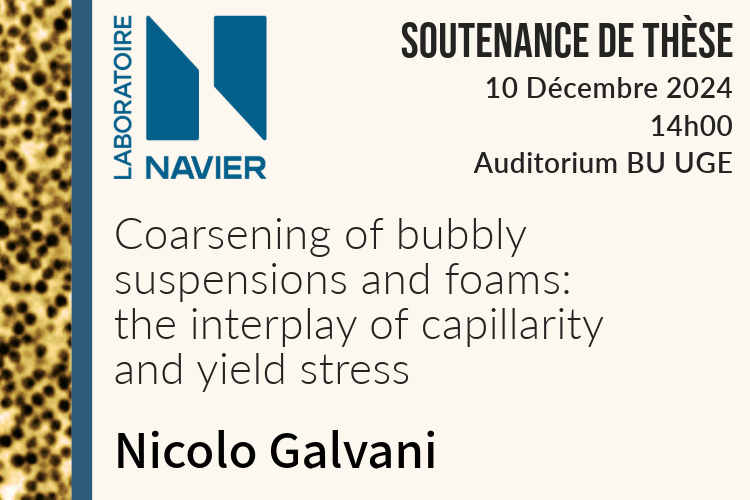
PhD Defense – Nicolo Galvani
- Post by: olivier.pitois
- 26 November 2024
- No Comment
Nicolo Galvani, a PhD candidate in the Rheophysics and Porous Media (RMP) team, will defend his dissertation titled “Coarsening of bubbly suspensions and foams: the interplay of capillarity and yield stress" on Tuesday, December 10, at 2:00 PM, in the auditorium of the University Library at Université Gustave Eiffel.
Composition of the jury:
- Christophe Raufaste – Professor, Université Côte d’Azur – Examiner
- Frédéric Restagno – Research Director, Université Paris-Saclay – Examiner
- Marie Le Merrer – Research Scientist, Université Claude Bernard Lyon 1 – Reviewer
- Guillaume Ovarlez – Research Director, Université de Bordeaux – Reviewer
- Olivier Pitois – Research Director, Université Gustave Eiffel
- Sylvie Cohen-Addad – Professor, Université Gustave Eiffel
Résumé de la thèse
Afficher le résumé
This dissertation explores the coarsening dynamics of bubble dispersions in both simple surfactant solutions and concentrated emulsions, which serve as model yield stress fluids. Liquid foams, prevalent in diverse industries, are key in applications from food to building construction, where their low density, high surface area, and insulation properties are valued. However, controlling their microstructure during solidification remains a challenge, especially due to foam aging mechanisms such as drainage, coalescence, and coarsening. Coarsening, driven by gas transfer from smaller to larger bubbles, is particularly difficult to arrest. The aim of this thesis is to investigate how yield stress fluids affect coarsening of wet foams and bubbly liquids, with the hypothesis that a sufficiently high yield stress could counteract bubble growth.
The research is based on experiments conducted both on Earth and in microgravity aboard the International Space Station (ISS), which allows to investigate bubble coarsening across a wide range of liquid fractions—from dry foams to dilute bubbly liquids. On ground, the evolution of the foam structure is observed by videomicroscopy at the surface of two ageing cells mounted on a clinostat, a classical one at fixed volume and one at controlled osmotic pressure, specially constructed for this study, whereas in microgravity the experiments were conducted during the first mission of the Soft Matter Dynamics instrument. We measure the size and morphology of individual bubbles on images acquired along the coarsening using image treatment and analysis with machine learning tools. We show that the natural bubble size distribution of a simple wet foam coarsening in the scaling state is hierarchical with a network of bubbles in contact and a population of small bubbles roaming through its interstices. A key finding is the abrupt change at the jamming transition between the coarsening behavior of wet foams, which follows a parabolic growth law for the average bubble size, and that of bubbly liquids, which follows a cubic growth law. Moreover we study the average bubble coarsening rate as a function of the liquid fraction and show how it is modified by the effect of the small adhesive forces observed between bubbles. A major consequence of these forces is that the change in coarsening regime is observed at a liquid fraction higher than that characterizing the Random Close Packing of spherical bubbles.
We study the coarsening of foamed emulsions as a function of the emulsion yield stress and foam liquid fraction. Our results show how the coarsening rate is damped by the plasticity of the emulsion and allow to assess the conditions for coarsening arrest.
Our analysis presents a comprehensive coarsening diagram based on the Bingham number and liquid volume fraction, identifying five distinct coarsening regimes according to three features: the average growth law, the individual bubble ripening, and the bubble morphology. This thesis contributes significantly to understanding the transition between capillary and plastic regimes in bubble dispersions and proposes models that could describe coarsening behaviour in various yield stress fluids.


